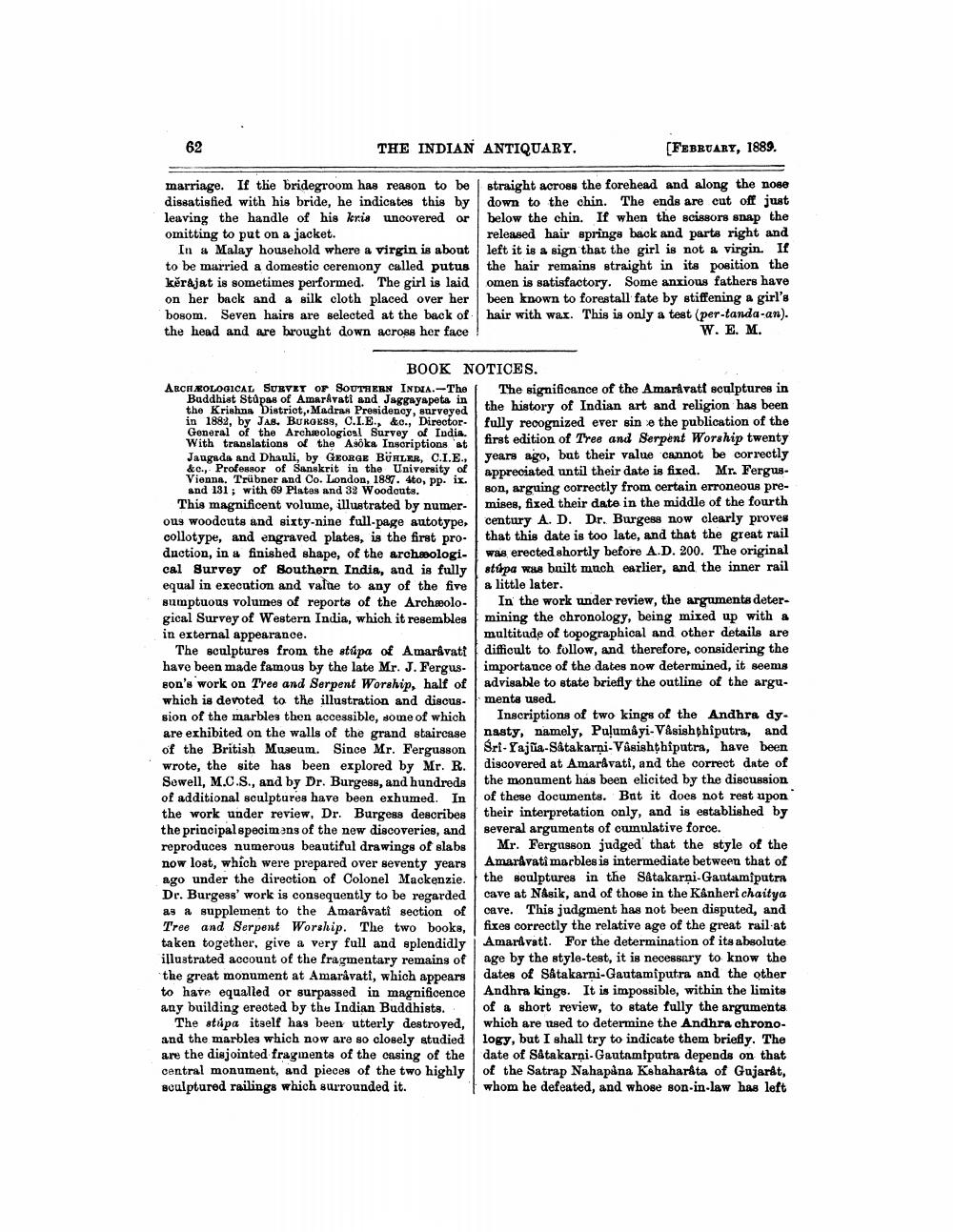________________
62
THE INDIAN ANTIQUARY.
[FEBRUARY, 1889.
marriage. If the bridegroom has reason to be straight across the forehead and along the nose dissatisfied with his bride, he indicates this by down to the chin. The ends are cut off just leaving the handle of his keris uncovered or below the chin. If when the scissors snap the omitting to put on a jacket.
released hair springs back and parts right and In a Malay household where a virgin is about left it is a sign that the girl is not a virgin. If to be married a domestic ceremony called putus the hair remains straight in its position the kérájat is sometimes performed. The girl is laid omen is satisfactory. Some anxious fathers have on her back and a silk cloth placed over her been known to forestall fate by stiffening a girl's bosom. Seven hairs are selected at the back of hair with war. This is only a test (per-tanda-an). the head and are brought down across her face!
W. E. M.
BOOK NOTICES. ARCHXOLOGICAL SURVEY OF SOUTHERN INDIA.-Thef The significance of the Amaravatt sculptures in
Buddhist Ståpas of Amaravati and Jaggayapeta in the Krishna District, Madras Presidency, surveyed
yea the history of Indian art and religion has been in 1882, by Jas. BURGESS, C.I.E., &c., Director fully recognized ever sine the publication of the General of the Archaeological Survey of India. With translations of the Asoka Inscriptions at
first edition of Tree and Serpent Worship twenty Jaugada and Dhauli, by GEORGE BÜRLER, C.I.E., years ago, but their value cannot be correctly &c., Professor of Sanskrit in the University of
appreciated until their date is fixed. Mr. Fergus. Vienna, Trúbner and Co. London, 1887. 4to, pp. ix.
and 131; with 69 Plates and 32 Woodcuts.“ Bon, arguing correctly from certain erroneous pre
This magnificent volume, illustrated by numer- mises, fixed their date in the middle of the fourth ous woodcuts and sixty-nine full page autotype, century A. D. Dr. Burgess now clearly proves collotype, and engraved plates, is the first pro- that this date is too late, and that the great rail duction, in a finished shape, of the archeologi- was erected shortly before A.D. 200. The original cal Survey of Southern India, and is fully stúpa was built much earlier, and the inner rail equal in execution and value to any of the five a little later. sumptuous volumes of reports of the Archæolo. In the work under review, the argumente detergical Survey of Western India, which it resembles mining the chronology, being mixed up with a in external appearance.
multitude of topographical and other details are The sculptures from the stúpa of Amaravati difficult to follow, and therefore, considering the have been made famous by the late Mr. J. Fergus. importance of the dates now determined, it seems son's work on Tree and Serpent Worship, half of advisable to state briefly the outline of the arguwhich is devoted to the illustration and discus- ments used. sion of the marbles then accessible, some of which Inscriptions of two kings of the Andhra dyare exhibited on the walls of the grand staircase nasty, namely, Palum yi. Vasishbhfputra, and of the British Museum. Since Mr. Fergusson Sri- Yajna-Satakarni-Väsishthiputra, have been wrote, the site has been explored by Mr. R. discovered at Amar vatl, and the correct date of Sewell, M.C.S., and by Dr. Burgess, and hundreds the monument has been elicited by the discussion of additional sculptures have been exhumed. In of these documents. But it does not rest upon the work under review, Dr. Burgess describes their interpretation only, and is established by the principal specimens of the new discoveries, and several arguments of cumulative force. reproduces numerous beautiful drawings of slabs Mr. Fergusson judged that the style of the now loat, which were prepared over seventy years Amaravati marbles is intermediate between that of ago under the direction of Colonel Mackenzie. the sculptures in the Satakarni.Gautamiputra Dr. Burgess' work is consequently to be regarded cave at Nasik, and of those in the Kanheri chaitya as a supplement to the Amaravati section of cave. This judgment has not been disputed, and
Tree and Serpent Worship. The two books, fixes correctly the relative age of the great rail at taken together, give a very full and splendidly | Amaravatt. For the determination of its absolute illustrated account of the fragmentary remains of age by the style-test, it is necessary to know the the great monument at Amaravati, which appears dates of Satakarni-Gautamiputra and the other to have equalled or surpassed in magnificence
Andhra kings. It is impossible, within the limits any building erected by the Indian Buddhists. of a short review, to state fully the arguments
The atúpa itself has been utterly destroyed, which are used to determine the Andhra chronoand the marbles which now are so closely studied logy, but I shall try to indicate them briefly. The are the disjointed fragments of the casing of the date of Satakarni Gautamiputra depends on that central monument, and pieces of the two highly of the Satrap Nahapana Kshaharata of Gujarat, soulptured railings which surrounded it.
whom he defeated, and whose son-in-law has left




